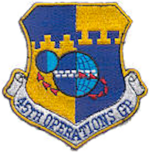This article has multiple issues. Please help improve it or discuss these issues on the talk page . (Learn how and when to remove these messages)
|
| 45th Operations Group | |
|---|---|
 Cassini–Huygens spacecraft launch, 15 October 1997 | |
| Active | 1941–1942, 1991–2021 |
| Country | |
| Branch | |
| Type | Group |
| Role | Space launch |
| Motto(s) | Ad Astra (Latin for 'To the Stars') |
| Insignia | |
| Patch with 45th Operations Group emblem (Approved 19 July 1967 for Air Force Eastern Test Range) [a] |  |
| 45th Bombardment Group emblem [b] [1] |  |
The 45th Operations Group was a United States Air Force unit. It was assigned to 45th Space Wing, stationed at Cape Canaveral Air Force Station, Florida. In May 2021, it was inactivated and its assetts reassigned to Space Launch Delta 45.
Contents
- Components
- History
- World War II
- Space operations
- Lineage
- Assignments
- Squadrons
- Stations
- List of commanders
- References
- Notes
- Bibliography
- External links
Up until 2003, the 45th Operations Group was responsible for program management and operation of up to five squadrons which perform all Eastern Range launch operations including Delta II, Delta III, Atlas II, Atlas III, Titan IV, Space Shuttle, Pegasus, and Athena space launch vehicles.[ citation needed ]
The group provided support to Naval Ordnance Test Unit operations. In support of space launch operations, it coordinated training for the wing, manages all wing spacecraft services systems and facilities, and manages the Cape Canaveral Space Force Station Skid Strip and the Patrick Air Force Base air traffic control complex, handling more than 24,000 aircraft operations annually.

